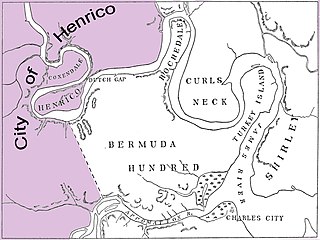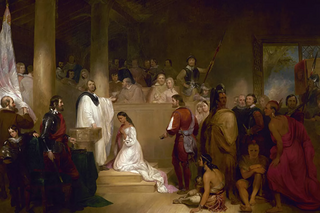Related Research Articles

The House of Burgesses was the elected representative element of the Virginia General Assembly, the legislative body of the Colony of Virginia.
Samuel Jordan was an early settler and Ancient Planter of colonial Jamestown. He arrived in Virginia around 1610, and served as a Burgess in the first representative legislative session in North America. Jordan patented a plantation which he called "Beggar's Bush", which later became known as Jordan's Journey. It became a safe haven and stronghold for settlers during the Second Anglo-Powhatan War that ensued after the Powhatan surprise attack of 1622.

Philip Cottington Ludwell was an English-born planter and politician in colonial Virginia who sat on the Virginia Governor's Council, the first of three generations of men with the same name to do so, and briefly served as speaker of the House of Burgesses. In addition to operating plantations in Virginia using enslaved labor, Ludwell also served as the first governor of the Carolinas, during the colony's transition from proprietary rule to royal colony.

The City of Henrico is one of the oldest counties in the Colony of Virginia. It was one of four incorporations established in the colony by its proprietor, the Virginia Company. The City of Henrico, which included the settlement of Henricus, was the furthest incorporation upstream on the James River. In 1634, Henrico was reorganized under royal authority as the shire of Henrico, one of eight shires in the Crown Colony of Virginia, Later, it became known as Henrico County, Virginia.

Jordan Point is a small unincorporated community on the south bank of the James River in the northern portion of Prince George County, Virginia, United States. It is about 20 miles from Richmond and 30 miles upstream from Jamestown on the James River. It was the location of extensive archeological research between 1987 and 1993. This research provided substantial information about human existence in the area from the prehistoric to the late colonial eras. In particular, the research extensively studied the Jordan's Journey settlement that existed between 1620 and 1640 during early years of the Virginia colony.

Jamestown, also Jamestowne, was the first settlement of the Virginia Colony, founded in 1607, and served as the capital of Virginia until 1699, when the seat of government was moved to Williamsburg. This article covers the history of the fort and town at Jamestown proper, as well as colony-wide trends resulting from and affecting the town during the time period in which it was the colonial capital of Virginia.
Temperance Flowerdew, Lady Yeardley was an early settler of the Jamestown Colony and a key member of the Flowerdew family, significant participants in the history of Jamestown. Temperance Flowerdew was wife of two Governors of Virginia, sister of another early colonist, aunt to a representative at the first General Assembly and "cousin-german" to the Secretary to the Colony.
William Powell, was an early Virginia colonist, landowner, militia officer and legislator. Considered an ancient planter for living in the Virginia colony during its first decade, he was one of two representatives from what became James City County, Virginia in the first Virginia House of Burgesses in 1619. His former plantation, now across the James River in Surry County, Virginia is now within Chippokes State Park.
Ensign Washer or Ensign Thos (Thomas) Washer was an early Virginia colonist who settled in the area that became Isle of Wight County, Virginia. Washer and Christopher Lawne represented Lawne's Plantation as burgesses in the first assembly of the Virginia House of Burgesses, the lower house of the colonial Virginia General Assembly, in 1619.

Reverend Richard Buck was a minister to the Colony of Virginia at Jamestown, Virginia from 1610 to 1624. He was chaplain of the first session of the Virginia General Assembly, which was composed of the House of Burgesses and the Virginia Governor's Council. This assembly met in the church at Jamestown on July 30, 1619, as the first elected assembly and law making body in colonial America.

William Farrar was a landowner and politician in colonial Virginia. He was a subscriber to the third charter of the Virginia Company who immigrated to the colony from England in 1618. After surviving the Jamestown massacre of 1622, he moved to Jordan's Journey. In the following year, Farrar became involved in North America's first breach of promise suit when he proposed to Cecily Jordan.
Cecily Jordan Farrar was one of the earlier women settlers of colonial Jamestown, Virginia. She arrived in the colony as a child in 1610 and was established as one of the few female ancient planters by 1620. After her husband Samuel Jordan died in 1623, Cecily obtained oversight of his 450-acre plantation, Jordan's Journey. In the Jamestown Muster of 1624-1625, she is one of fewer than 10 women who are mentioned as a head of household, and the only woman listed as sharing the head of household with a man she was not married to. In the year of Samuel Jordan's death, she set off the first breach of promise lawsuit in English North America when she chose the marriage proposal of William Farrar, who was bonded to help settle her estate, over that of Greville Pooley, who claimed his proposal had already been accepted. In 1625, Cecily prevailed when Pooley withdrew his claim. Afterward, she married William Farrar.
William Spence was an early Virginia colonist on Jamestown Island. He was member of the first assembly of the Virginia House of Burgesses in Jamestown, Virginia in 1619. Spence became an ensign in the local militia and is thus sometimes identified as Ensign William Spence or Ensign Spence. He was an early farmer on Jamestown Island, a tobacco taster and landowner at Archer's Hope. He, his wife and his young daughter, Sara, or Sarah, avoided the Indian massacre of 1622, but Spence and his wife were reported "lost" at the census of February 16, 1624.
William Spencer was an early Virginia colonist on Jamestown Island, who was an Ancient planter and a member of the Virginia House of Burgesses in Jamestown, Virginia for Mulberry Island in 1632/33.
William Sharpe was an early Virginia colonist, soldier, ancient planter, and Virginia Company shareholder who settled in the Bermuda Hundred area that became part of Charles City County, Virginia. He served in the Virginia House of Burgesses in Jamestown, Virginia, in 1629.
Edmund Rossingham was the nephew of and factor or agent for Sir George Yeardley, who was Governor of the Colony of Virginia, three times between November 1616 and November 1627, and his wife Temperance Flowerdew. Rossingham was a member of the first assembly of the Virginia House of Burgesses at Jamestown, Virginia in 1619 for Flowerdew Hundred Plantation, Yeardley's plantation.
John Pollington was an early Virginia colonist who was a member of the first assembly of the Virginia House of Burgesses at Jamestown, Virginia in 1619 for the "Citie" of Henricus, Virginia. In 1624, he was a burgess for Warrosquyoake Shire sometimes shown as Warresqueak and other variations, now Isle of Wight County, Virginia. He also was a landowner and merchant.
Robert Stacy was a colonist and politician in the Colony of Virginia who briefly served as one of the 22 members of the first assembly of the Virginia House of Burgesses in 1619.
William Peirce, emigrated with his family to the new Colony of Virginia, where he became a valued soldier, as well as a planter, merchant and politician. Although Peirce fought in several skirmishes with Native Americans and served in both houses of the Virginia General Assembly as well as helped topple governor John Harvey, today he may best be known as one of the first slave owners in the colony.
Otto Thorpe or Thorp(1630-winter of 1696/1697) was an English merchant who became a militia officer and politician of Middle Plantation in the Colony of Virginia. His home was commandeered during Bacon's Rebellion, and in April 1682, Thorpe briefly represented York County in the House of Burgesses, before returning to England, where he died more than a decade later.
References
- Bernhard, Virginia. The Tale of Two Colonies: What Really Happened in Virginia and Bermuda?. Columbia, MO: University of Missouri Press, 2011. ISBN 978-0-8262-1951-0.
- Glover, Lorri and Daniel Blake Smith. The Shipwreck That Saved Jamestown: The Sea Venture Castaways and the Fate of America]. New York: Henry Holt and Company, LLC, 2008. ISBN 978-0-8050-9025-3. Retrieved May 5, 2013.
- Grizzard, Frank E. and Dennis Boyd Smith. Jamestown Colony: A Political, Social and Cultural History. Santa Barbara, CA: ABC-CLIO, 2007. ISBN 978-1-85109-637-4.
- Haile, Edward Wright, ed. Jamestown Narratives: Eyewitness Accounts of the Virginia Colony: The First Decade: 1607-1617. Champlain, VA: RoundHouse, 1998. ISBN 978-0-9664712-0-5.
- Henings, Statutes at Large, shown as Virginia, William Waller Hening, Virginia (Colony). The statutes at large: being a collection of all the laws of Virginia. Volume 1, Richmond, VA: Printed by and for Samuel Pleasants, Junior, printer to the Commonwealth, 1809-1823. OCLC 15444366. Retrieved July 15, 2011.
- Henry, William Wirt. The First Legislative Assembly in America. In Annual Report of the American Historical Association for the Year 1893. Washington, Government Printing Office, 1894. OCLC 1150082. Retrieved July 21, 2011.
- McCartney, Martha W. Virginia immigrants and adventurers, 1607-1635: a biographical dictionary. Baltimore: Genealogical Pub. Co., 2007. ISBN 978-0-8063-1774-8.
- McIlwaine, H. R., ed. Volume 1 of Journals of the House of Burgesses, 1619 - 1658/59. Richmond, VA, 1915.
- Price, David A. Love & Hate in Jamestown: John Smith, Pocahontas and the Start of a New Nation. New York: Vintage Books, a Division of Random House, Inc., 2003. ISBN 978-1-4000-3172-6.
- Stanard, William G. and Mary Newton Stanard. The Virginia Colonial Register. Albany, NY: Joel Munsell's Sons Publishers, 1902. OCLC 253261475, Retrieved July 15, 2011.
- Tyler, Lyon Gardiner Sharpe, Samuel in Encyclopedia of Virginia biography. New York: Lewis Historical Pub. Co., 1915. OCLC 866770546. Retrieved July 21, 2011.